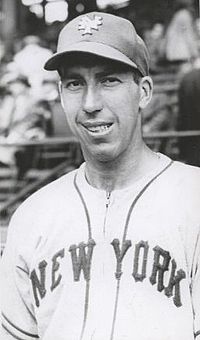
Throughout the history of Major League Baseball, there has only been one other player with the last name of Gee. In the 1940s, there was a left handed pitcher by the name of Johnny Gee, who pitched in the majors for the Pittsburgh Pirates and New York Giants. At 6'9, he was the tallest player in the history of MLB until LHP Randy Johnson made his big league debut. Another thing that stood out about Johnny Gee was his athletic ability. He was scouted heavily while he pitched at Syracuse University and was very much sought after during his time pitching in the minor leagues. In fact, the Pirates purchased him in 1939 for $75,000 and four players which was the highest price the Pirates payed for a player until they purchased Hank Greenberg in 1947.
Unfortunately, Gee never lived up to the expectations. Pitching 6 seasons with the Pirates and Giants, he was 7-12, 4.41 in 44 career games, 21 starts. He made his debut in 1939, shortly after his purchase from the minors. He started 3 games, going 1-2, 4.12 with 16 Ks in just over 19 IP. However, in spring training the following season, Gee suffered an arm injury that he would never recover from. He missed the entire 1940 season and pitched in a total of 5 games (3 with the Pirates) in the 1941 season. Ineligible for service in World War II due to his height (max height was 6' 6), he continued to struggle to gain the strength needed to be a major league pitcher. He would apply for Commissioner Kenesaw Landis for retirement, which was granted.
The next season, Gee seemed to regain his arm strength and returned to the big leagues. He would have his biggest impact on the Pirates this season, pitching in a career high 15 games (10 starts), going 4-4 in 82 innings, but recording just 18 Ks. A year later, after appearing in 4 games out of the Pirates bullpen, Gee was sold to the Giants, where he would appear in another 4 games for New York. He would only get into 2 MLB games for the Giants in 1945 and in his last big league season in 1946, he got into 13 games, 6 as a starter with a 2-4, 3.99 stat line. He would appear in 6 games for the 1951 Auburn (NY) Falcons of the Border League, ranked as a C League team.
Because of his arm injury, Gee spent a lot of time debating whether he should continue to pitch. An educated man, he made sure he maintained another job as a fallback option in case his arm never recovered. He was the physical education director of Waterloo High School and insisted on completing the school year before reporting back to the Giants. Of course, this effected his relationship with the Giants and manager Mel Ott. Because there was no agreement on a contract between Gee and the Giants, he was considered a holdout and was not eligible to pitch professional baseball in 1947 and 1948.
There was another reason why Gee did not play professional baseball in 1947. He joined the Syracuse Nationals of the National Basketball League for the 1946-1947 season. Because of the fact that he would not leave his teaching job at Waterloo, Gee played in only home games but managed to lead the team in scoring during its first victory of the season. Gee was replaced as starting center the following season as his team found a starting center that can play in road games.
Johnny Gee lived a very long and successful life. He played major league baseball (though he never lived up to the hype) as well as professional basketball. He was a well educated teacher and obtained his masters degree at Syracuse and was a school principal and eventually a code enforcement officer for the City of Cortland. His name was used in a classic 1969 song by David Frishberg called "Van Lingle Mungo." Gee passed away in 1988 at the age of 72 in Cortland, NY.


 RSS Feed
RSS Feed
